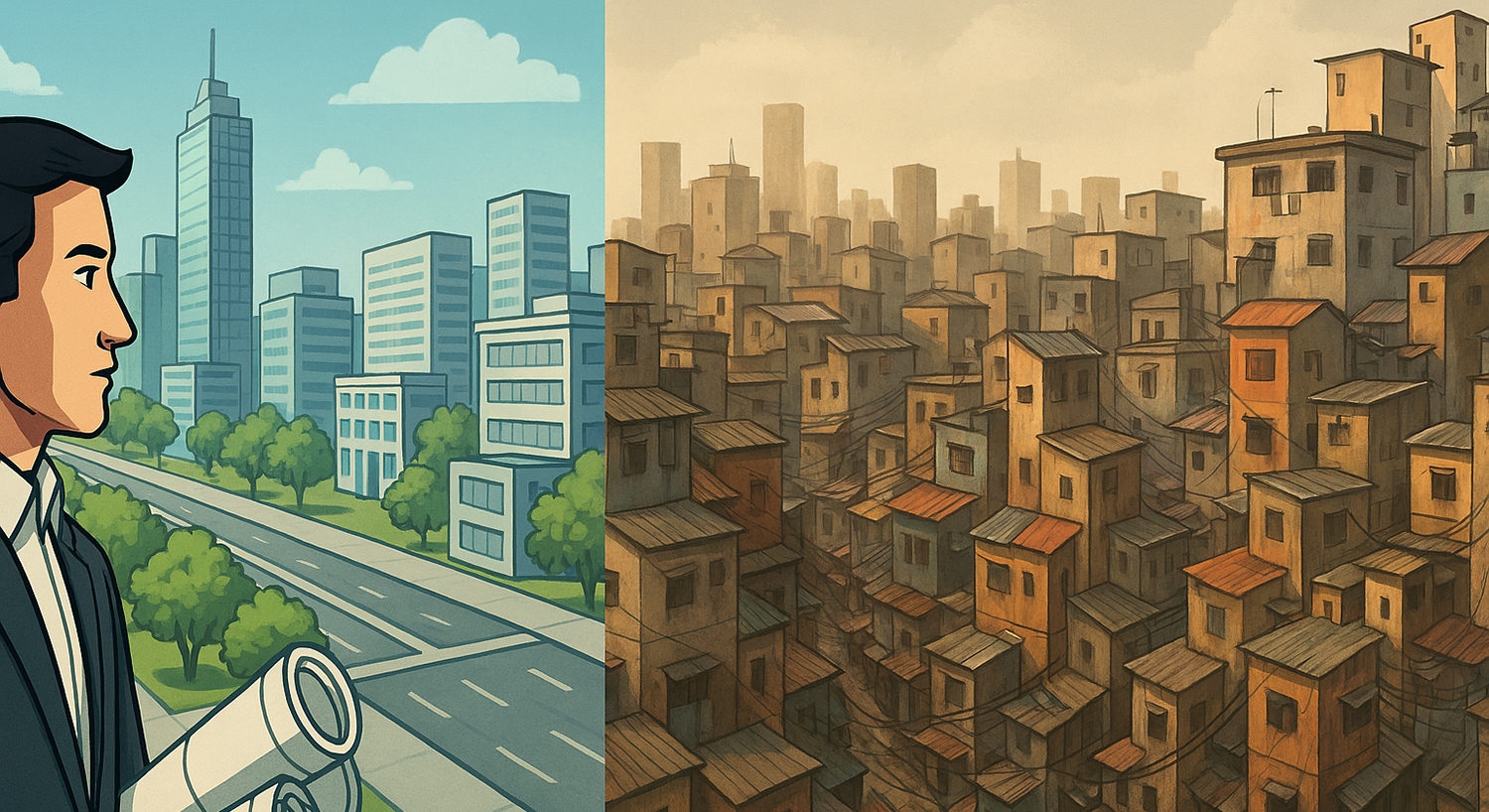
Is Dhaka city livable?
A Planned City vs. Unplanned Dhaka: An Urban Planner’s Experience
Last month, on the 5th, the day was bright, clear, and sunlit – no trace of clouds in the sky, and the air carried a refreshing crispness. After departing from Dhaka and spending a long 25 hours in transit, my plane finally entered the skies of this unfamiliar, unknown city. At that very moment, I felt that a new chapter of life was about to begin. After passing through many springs, leaving behind countless memories and experiences, I was stepping into a city where a new life awaited me. I had spent many years in Bangladesh’s largest city, the capital Dhaka. Although my childhood, adolescence, and professional life were intertwined between a remote village in Bangladesh and Dhaka, the city never became dear to me. What we mean by a humane city – a place that is safe, simple, and orderly for its citizens – Dhaka is far from that. Now I’m arriving in a new city, one I know nothing about, where every moment will feel like a new discovery. From the sky, I could already see the roads, buildings, and parks of the city – everything appeared neatly arranged. In university textbooks, I had read about the grid-iron pattern, which was used as the foundation of urban planning in ancient Greek civilization. That same pattern is still effectively used in modern urban management. Seeing that beautiful planning unfold before my eyes in reality was almost unbelievable. Again and again, I was reminded of Dhaka’s chaotic, disorganized, and arguably unplanned roads – where people suffer indescribable hardship every day. As an urban planner, I could immediately tell that this city’s planning was far more advanced than Dhaka’s, even though Dhaka is comparatively older.
Dhaka’s disorganized planning – or rather, its lack of planning – has left it far behind compared to this city. After starting to live here, I’m realizing more and more each day how crucial urban planning is, and how deeply it affects people’s daily lives. A well-planned city can make life easier, more dynamic, and safer – this city is a living example of that. Every road, every intersection, every structure seems to be part of a coherent design. Moving around here feels like the city was built for its residents – with their comfort, safety, and convenience prioritized.
The road connectivity here is so well-organized that you can easily travel from one end to another using Google Maps. The greatest advantage of the grid-iron pattern is that once you enter a street, you can easily reach another – dead ends are almost nonexistent, and winding roads are rare. On the other hand, in Dhaka, if someone unfamiliar enters the streets without proper directions, reaching their destination becomes extremely difficult. Dead ends are a daily occurrence, and roads often widen and then suddenly narrow, creating major obstacles for traffic flow. For example, in this city, you can reach any metro station or subway directly, but in Dhaka, reaching a bus terminal requires navigating through a maze of turns. Even with modern tools like Google Maps, you can’t move forward properly without someone’s help. In contrast, the road network in this city is so well-structured that you can travel independently and reliably with just technological assistance.
Most roads in this city are virtually free from traffic jams. There are traffic signals, and people follow them, but you don’t have to sit for hours. As a result, life maintains its pace, and time is used efficiently. On one hand, this saves hundreds of productive hours for people, and on the other, it accelerates economic progress. It reflects sound planning and effective management. In contrast, Dhaka suffers from a shortage of roads relative to demand, an increase in private vehicles, unplanned traffic systems, citizens ignoring traffic laws, and a lack of proper public transportation – all of which contribute to daily gridlock. Traffic jams waste valuable time, reduce productivity, and affect concentration. Students, professionals, and people from all walks of life suffer daily. Every day, 3.2 million work hours are lost due to traffic congestion, which is a massive blow to the economy. In 2004, the average vehicle speed in Dhaka was 21 km/h; now it has dropped to just 7 km/h. The public transport system is in disarray – there aren’t enough buses, no fixed routes, and no adherence to schedules. Pedestrians lack basic facilities, and whatever little exists is occupied by vendors who bribe police and authorities to set up shops and markets. It’s a daily sight to see construction materials piled up on roads by influential individuals.
The city I now live in is one of the world’s most earthquake-prone cities, yet it’s far less risky than Dhaka. Most buildings here are made of wood – a form of indigenous technology. This wasn’t adopted overnight; it evolved over centuries through experiences of major earthquakes and destruction. Building regulations are strictly followed here, and people are highly conscious of their own safety. In recent times, there hasn’t been any major disaster or significant loss of life reported. On the other hand, Dhaka is extremely densely populated, and if a major earthquake were to strike, the damage would be unimaginable. Dhaka-centric urbanization is not sustainable, and every aware citizen realizes this. Yet people can build high-rise concrete buildings wherever they want. Corrupt officials in regulatory bodies approve these constructions in exchange for bribes and never conduct follow-up inspections. Dhaka does have a land use plan, but it’s rarely followed. In 2013, a building collapsed in Savar near Dhaka, killing over 1,300 garment workers – a tragedy known as the Rana Plaza disaster. It shook the world, yet unplanned and unsafe urbanization, especially in construction, continues unabated.
When it comes to civic amenities, the people in my current city are far better off. The roads here are wide, and there are hardly any high-rise buildings. This makes planning for public services much easier. The population density here is 2,910 people per square kilometer. Everyone has access to 24-hour electricity, water, and gas. I’ve never experienced a power outage. If a fire breaks out or an accident occurs, fire services and rescue teams can reach the spot quickly. In contrast, Dhaka has 43,223 people per square kilometer. A 20-story building might stand right next to a shack or rows of slums. The roads are narrow, broken, and unsafe. Power outages are a daily affair. Water is unavailable for long hours, and due to gas shortages, people struggle to cook properly. There are many other civic rights I won’t even mention in this brief space. As one of the world’s largest megacities (currently ranked 11th), Dhaka’s disorderly growth and expansion hinder access to basic urban services.
Dhaka has failed to utilize the opportunities it has been given. Naturally, the city is surrounded by many small and large rivers. These rivers could have been the primary mode of transportation for Dhaka, but that didn’t happen. Pollution, encroachment, corruption, and lack of coordination have rendered them nearly lifeless. With so many rainy days each year, water flow and river connectivity should not have been a problem. In contrast, if we look at my current city, we see there are hardly any rivers, and it hasn’t rained in a long time. Compared to Dhaka, water sources here are limited, and challenging projects must be undertaken to secure water. There’s no opportunity to transport goods or people via waterways. If there were, perhaps they would have utilized it. This is evident from how beautifully they’ve decorated an artificially created canal – maintained meticulously by the city authorities. On the other hand, Dhaka continues to expand without any planning. Wetlands have been filled, canals encroached and buried, and box culverts built in places. As a result, rainwater has nowhere to drain.
Many more aspects could be highlighted that clearly show this large city in this country is far more planned than Dhaka, the capital of Bangladesh in Asia. Whether there’s a plan on paper, a master plan, or a land use plan is less important than whether the planning is visible. The structured planning of this city is visibly evident, and when compared to Dhaka, it appears several times more superior – even to the naked eye.
Special Note: For understandable reasons, I have deliberately chosen not to disclose the name of my current country and city. My life in Bangladesh was extremely unsafe and fraught with danger; at any moment, I feared being attacked or killed by Islamic fundamentalists. Due to my secular and humanist activism and writing, I received multiple death threats from Islamist militant groups. Once, they created a mob in front of my house and attempted to kill me. I was physically assaulted, and I still carry the scars from that attack. Even today, they threaten to slaughter me and demand to know my whereabouts. That is why I do not make my current location public.
Related Posts

In the Shadow of Famine: Bengali Food Habits – History, Practice, and Bodily Burden
About 10-12 days ago.I went to a large wholesale store, where products are usually soldRead More

দূর্ভিক্ষের ছায়ায় বাঙালির খাদ্যাভ্যাসঃ ইতিহাস, অভ্যাস ও শরীরের দায়
প্রায় ১০-১২ দিন আগের ঘটনা। একটি বড় বিপণিবিতানে গিয়েছিলাম, যেখানে সাধারণত বক্স ধরে পণ্য কিনতেRead More

Are religion, country, race, patriotism, and nationalism all racist concepts?
The only uncontacted human tribe left in the world today are the Sentinelese of NorthRead More

Comments are Closed